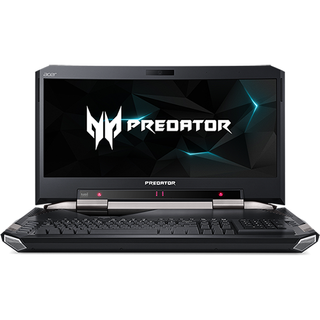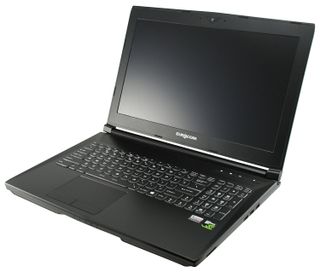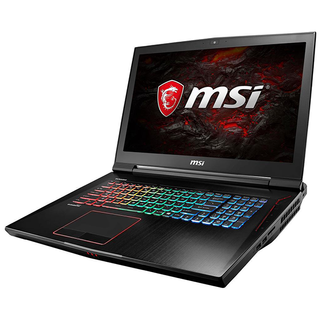Origin PC EON17-SLX Gaming Laptop Review
Why you can trust Tom's Hardware
Synthetic Benchmarks
The Origin PC EON17-SLX is arguably the most powerful gaming laptop we’ve ever tested, besting even the Acer Predator 21 X in terms of raw specs. It features a desktop class 7th-generation Intel Core i7-7700K and two Nvidia GeForce GTX 1080s running in SLI. It contains 16GB of DDR4-2400 memory, a 512GB M.2 SSD, and a 2TB 5400RPM hybrid HDD for added storage. To put the desktop processor and dual GTX 1080 configuration to good use, the EON17-SLX features a 17.3” Ultra HD (3840x216) matte IPS display with G-Sync running at 60Hz.
The Acer Predator 21 X features the overclockable 7th-generation Intel Core i7-7820HK, which we've only seen in the MSI GT73VR Titan SLI 4K. It has two Nvidia GeForce GTX 1080s, making it a graphical powerhouse as far as laptops (if we can even use that word) go. It contains 64GB of DDR4-2400 memory, two 512GB M.2 SSDs running in RAID 0, and a 1TB 7200RPM HDD for added storage. But those qualifiers pale in comparison to the 21" Wide-FHD (2160x1080) matte IPS display with G-Sync running at 120Hz. In terms of gaming performance, this will the the EON17-SLX’s primary competitor.
Next is the MSI GT73VR Titan SLI 4K, another dual graphics configuration. Like the Predator 21 X, it contains an overclockable i7-7820HK, but has two less powerful GTX 1070s. It also contains 32GB of DDR4-2400 memory, two 256 GB M.2 SSDs running in MSI’s Super RAID 4, and a 1TB 7200RPM drive for additional storage. Like our Origin PC, the Titan SLI 4K has a 17.3” UHD matte IPS display.
Our lowest-end system in this comparison is the Eurocom Tornado F5, but it’s a formidable system. The Tornado F5 review hasn’t been published yet, so stay tuned! It matches the Origin PC with an i7-7700K, but only contains one GTX 1080. It also has 16GB of DDR4-2400 memory, a 250GB M.2 SSD, and a 1TB 7200RPM HDD for additional storage. The Tornado F5 only has a 15.6” Full HD (1920x1080) IPS display with a matte coating. While it doesn’t have the raw gaming performance of its competitors, it should go head to head with the EON17-SLX in platform-based synthetic tasks.
3DMark




3DMark’s game-like workloads give us a sneak peak at what our gaming benchmarks might who. The Origin PC EON17-SLX stands far ahead of the competition. Graphics-wise, it stands toe-to-toe with the Acer Predator 21 X, but its desktop-class processor gives it the upper hand in Physics workloads and at higher resolutions. You’ll see similar CPU-based results with the Eurocom Tornado F5, which also has an i7-7700K CPU.
Cinebench R15
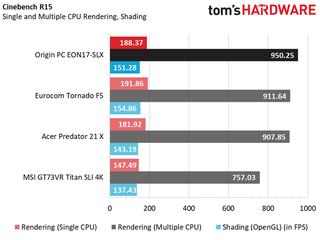
The 3DMark Physics tests foreshadowed the EON17-SLX’s Cinebench victory. The Origin and Eurocom laptops trade blows, with the Tornado F5 winning in single core rendering and the EON17-SLX firing back in multi-core rendering. The desktop-class processor grants the Origin a 5% edge in OpenGL shading compared with the Predator 21 X. The second GTX 1080 is essentially useless during the shading test, where the single-GPU Eurocom performs roughly the same as the Origin system.
CompuBench
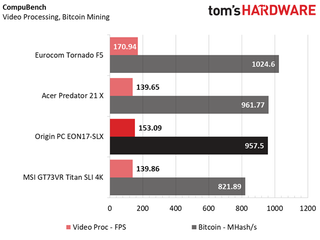
CompuBench features a CPU-based Video Processing test and a GPU-based Bitcoin Mining test. Unfortunately, these workloads don’t support SLI configurations, so although the EON17-SLX outperforms the Acer in Video Processing, the perform evenly in Bitcoin Mining.
IOMeter


We perform an IOmeter test on each laptop’s primary drive to measure basic random and sequential read and write speeds. The EON17-SLX contains a 512GB Samsung 960 Pro M.2 SSD, whereas the similarly configured Predator hosts double the storage capacity with two 512GB Toshiba OCZ RD400 M.2 SSDs. The MSI’s Super RAID configuration is composed of two 256GB Samsung SM951s, matching the Origin’s capacity. The Eurocom has the smallest storage configuration out of the bunch, with a 250GB Samsung 960 EVO.
The EON17-SLX delivered the slowest random 4K read speeds out of the bunch, but the highest write speeds. Meanwhile, it outperforms the competition in 128K sequential read speeds and narrowly loses to the two RAID configurations in sequential write speeds.
PCMark 8

To approximate a system’s common workday performance, we use PCMark 8’s Microsoft Office and Adobe Creative tests. These platform-based tasks benefit greatly from CPU performance, so the Tornado F5 scores well because of its desktop Core i7 CPU. However, adding another GTX 1080 to the mix boosts the EON17-SLX to first place. Meanwhile, both i7-7820HK-equipped laptops falter, especially during the Adobe Creative test.
MORE: Best Gaming Laptops
MORE: Gaming Laptop Previews
MORE: All Laptop Content
Current page: Synthetic Benchmarks
Prev Page Introduction & Product Tour Next Page Gaming BenchmarksStay on the Cutting Edge
Join the experts who read Tom's Hardware for the inside track on enthusiast PC tech news — and have for over 25 years. We'll send breaking news and in-depth reviews of CPUs, GPUs, AI, maker hardware and more straight to your inbox.

Thermalright Frozen Notte and Aqua Elite 360 White V3 Review: Strong AIOs available for less than $65

Intel received €30 million from Ireland to offset higher EU power bills — Ireland and Intel continue a tight partnership in chip fabs

Get $500 off this Alienware Aurora R16 with RTX 4080 Super and Core i9-14900KF
-
g-unit1111 What's up with laptop manufacturers including A/C adapters that are the size of a small textbook? Does it really take a huge A/C adapter to power laptops these days?Reply -
Rookie_MIB Heck, at $3600 for the MSI, you could take the difference and build a VERY good full blown desktop class gaming machine.Reply -
the nerd 389 Just curious:Reply
Have you guys ever considered testing using an external display so you can do a frame-time/F-CAT analysis?
I get the feeling that the cooling solution in this laptop is coming up short, and that would show up in your frame time variance tests. -
TMTOWTSAC To be fair, trying to effectively cool a pair of 1080's along with a 7700k plus a 4k screen all shoehorned into an 18 inch laptop would probably require the bottom of the laptop to consist entirely of fans at rpms so high the laptop hovers in midair.Reply
Actually...that would be a completely awesome no-lap-needed computer/drone. -
TJ Hooker Reply
Why "LOL"? If the cooling solution is insufficient, the components could throttle (intermittently), resulting in stuttering, which would show up in frame time measurements.19980951 said:"cooling solution"
"show up in your frame time variance tests."
LOL -
FritzEiv Reply19981179 said:
Why "LOL"? If the cooling solution is insufficient, the components could throttle (intermittently), resulting in stuttering, which would show up in frame time measurements.19980951 said:"cooling solution"
"show up in your frame time variance tests."
LOL
In many of our laptop reviews now, especially when we started seeing odd behavior with Max-Q laptops, we started looking at temperatures during gaming benchmark runs. When we see results that don't seem quite right (say two laptops share a configuration -- GPU, CPU, DRAM), we're going back and re-running the tests; and in fact, we're starting to collect more of this information just so that we have it, since we do have to send these samples back.
Further, we have discussed showing more frame time data, just like we do in our gaming tests on CPUs and Graphics Cards. We're in the middle of re-tooling some of our scripts, but once we have that pretty much automated, we may start doing that in our laptop reviews.
Finally, we're also trying to up our game, so to speak, in all areas here. We've done some display calibration, we've had Chris Ramseyer devise some better storage tests, and Igor has worked with us on dialing in the thermal imaging. We'll keep pushing all of it, so thanks for the suggestion(s). -
Kunra Zether I like the overall design it's nice and clean cut , I really love the led accents on the back of the screen. I feel like at this price point they should have a mechanical keyboard minus the number pad section. There should definitely be a better quality touch pad, and plastic really?? How about aluminum or even steel I mean at over $4K they give you plastic and on top of it I think you could design a better bezel around that screen too. Unfortunately aswell it sounds like that display is lacking aswell.Reply
Just build a nice home PC for about 2 to 3K and get a 1060 gaming laptop for on the go much better deal. -
lazymangaka I can't help but think if you need 2 AC adapters, you've gone too far in stuffing the laptop full of hardware.Reply
Also, why do you need 2 AC adapters, but they're still able to combine down to a single port? That seems like a lot of power to pack into one little port. -
ledhead11 My family asked and help pitch in years ago for an MSI GT80 TITAN 980M SLI rig for graduation. Mostly happy other than feeling burned when MSI abandoned various levels of support for it.Reply
That being said, it was one of the final of these types of SLI monsters to feature the single brick.
@Just curious:
"Have you guys ever considered testing using an external display so you can do a frame-time/F-CAT analysis?
I get the feeling that the cooling solution in this laptop is coming up short, and that would show up in your frame time variance tests."
For awhile I had it hooked up to a couple of different displays(a 1080p/120hz/3d and 1440p/144hz/3d). I can at least tell you that yes, if the external display offers greater potential the rig will do its best and eventually throttling happens. I never did f-cat with mine but did do plenty of gaming. Ultimately I just use it's built-in display now and as a portable high end desktop between work and home.
Now years later having built/upgraded my desktops to 1 1080TI and the other 1080 SLI I really feel they should just abandon any SLI and just stick with a 1080TI/1440p-144hz Gsync. I know they don't exist yet but honestly that would be the best path IMO. Less power, less heat, maybe back to single brick, smaller chasis/case(maybe) and a screen that would impress most hardcore gamers.
